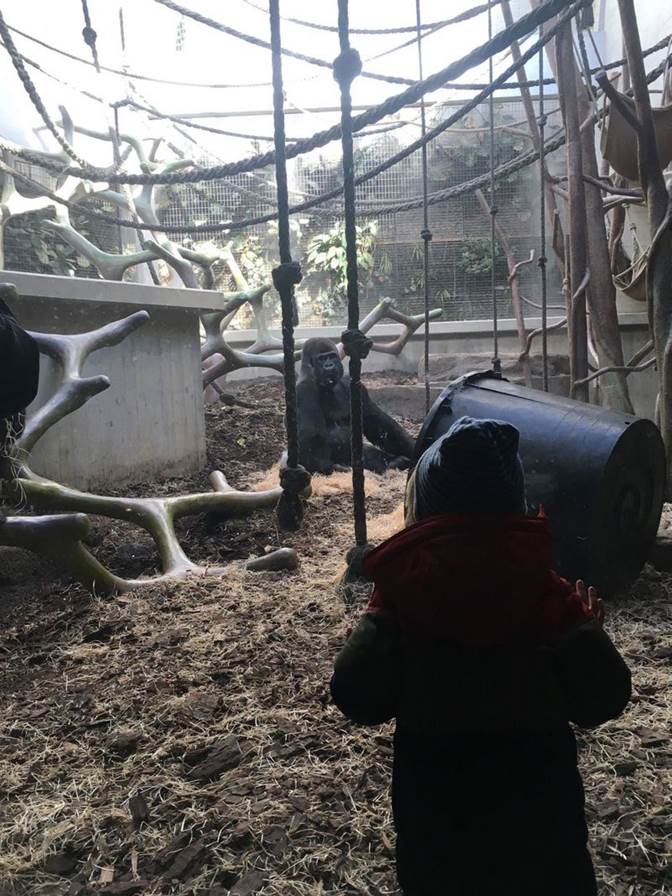Zoo Basel
Binningerstrasse 40, 4054 Basel
By Salome Rohner
Zoo Basel

Figure 1 A child watching a gorilla. Photo S. Rohner
11.2.2022
The Basel Zoo, known locally as the "Zolli", is the oldest
zoological garden in Switzerland and was opened in 1874 with the aim of
introducing the urban dwellers to the flora and fauna of their homeland. In the
late 19th century zoos were founded in many European cities. The
classification and systematization of nature is very typical for modernity, a
cultural complex that evolves in Europe after the “era of enlightenment” and
that is closely intertwined with the history of colonization. The construction
and hegemonization of a rationalized worldview by imperial forces finds a perfect
expression in the zoo. This became a space of representation for the modern
view of nature, which also served as propaganda for the progressive
colonization of non-European countries.
Because visitors to the Basel Zoo wanted more exotic exhibits soon
after the opening, the zoo's focus shifted from alpine animals to foreign
species, which shared the public’s attention in the zoo with touring
exhibitions and circuses. Such ensembles, which traveled throughout Europe,
often consisted not only of animals, but were intended to show the
comprehensive "way of life" of another place and culture, and
therefore also included the people and their dwellings. These were staged
together with the animals to give visitors a complete impression of everyday
life in the place in question.

Figure 2 Poster
Völkerschau, 1932, State Archives Basel-Stadt.
The so-called “Völkerschauen” that were held on the meadow where today
the flamingos are housed, are one of the most problematic aspects of Zolli’s
past. Their history and conception are entangled with the origins of today’s
zoological gardens. Carl Hagenbeck, a tradesman for exotic animals and the
alleged inventor of the modern zoo started to exhibit people in his zoos and
circuses in the late 19th century. The Zoo Basel hosted 22
“Völkerschauen”, among them 3 were organized by Hagenbeck himself. For about 75
years these racist and exploitative exhibitions that also worked as propaganda
for the colonist activities by Europeans on other continents, were widely
accepted. For the “anthropological-zoological” attractions, people from all
over the world were transported to Europe, touring for months through the
countries, were paid very badly or not at all and were exposed to medical and
mental strains.
Hagenbeck’s heritage has contributed to the history of the zoo in many
ways. Even though “human zoos”, as they were called by the people, were
prohibited around the 1940ies in Switzerland, the depiction of western power
over “exotic animals” and non-European people that had been promoted by them
stays at the conceptual origin of the zoo. Hagenbeck’s vision of a “Zoological
Paradise” has influenced the presentation of animals in zoos all over the
world.

Figure 3 Postcard with Hagenbeck’s panorama in the
Hamburg Zoo, author unknown 1909, Creative Commons.
Instead of in a cage, the animals are staged in a built landscape
representing their “natural habitat”, creating a panorama within a
romanticized, artificial nature. Until today, in many zoos the architecture of
the enclosures imitates the original surroundings of species and is sometimes
even completed with depictions of indigenous buildings. We suppose that such
exoticized representations of foreign cultures is reminiscent of the
”Völkerschau” and contributes to the practice of “othering”. The Zoo Basel
today pursues a different style of exhibition that tries to focus on the animal
and the regeneration and preservation of species. Apart from its prominent
position in the city both in a spatial and historical sense, the Zolli is a good starting point
to reflect on colonialism in Switzerland. With its ability to reflect
global orders and cultural relations, and its reach to a wide audience, it
could play an important role in the decolonization of Swiss society.

Figure 4 Giraffes in the zoo. Photo
S. Rohner 4.2.2022.
References
Gregory,
D. (2004). The Colonial Present: Afghanistan, Palestine, Iraq (Illustrated
ed.). WB.
Lutteroth,
J. (2013, April 12). a-56b4a247-0001-0001-0000-000000951096.
DER SPIEGEL, Hamburg, Germany. https://www.spiegel.de/geschichte/tierpark-begruender-carl-hagenbeck-a-951096.html#fotostrecke-54351010-0001-0002-0000-000000110303
Rothfels,
N. (2002). Savages and Beasts: The Birth of the Modern Zoo (Animals, History,
Culture). Johns Hopkins University Press.
Staehelin, B. (1993). Völkerschauen im
Zoologischen Garten Basel (1879–1935). Basel: Basler Afrika Bibliographien.
Zoo Basel. (n.d.). Völkerschauen im. Retrieved 20 January 2022,
from https://www.zoobasel.ch/de/aktuelles/blog/3/zoo-geschichte/160/voelkerschauen-im-zoo-basel/